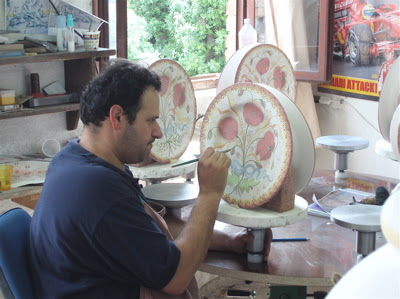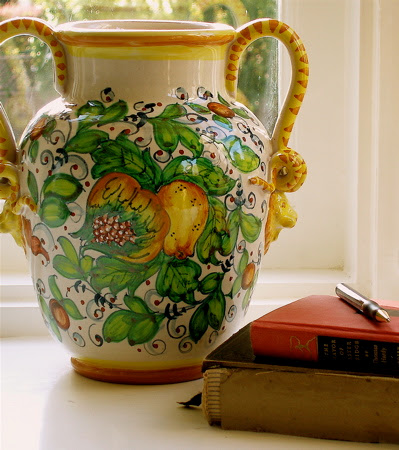Fine Italian ceramics are nothing new. Dating back to the Middle Ages and beginning to flourish in the 1400s, the ceramic centers of Italy have been producing incredibly detailed ceramics for literally hundreds of years. I recently came across a little book discussing Italian and other European ceramics throughout history – Mailolica, Delft and Faïence by Giuseppe Scavizzi – and wanted to share some of its beautiful images with you. Just look at the inside of this “loving cup” from circa 1500 Faenza, used to celebrate engagements or as a gift for a beloved:
The detailed likeness is strikingly similar to work by Tuscia d’Arte, such as this Italian canister.
Another timeless piece is this plate of a solider from circa 1630:
He looks so jaunty, reminding me of this contemporary Italian ceramic plate with a drummer at its center.
One of the amazing things about hand painted Italian pottery is that patterns and techniques have been passed down through generations. Artists today hand paint using the same process as those centuries ago, following traditional patterns as well as  adding some contemporary touches. Historically important areas for Italian ceramics have stayed pretty constant throughout the years, many of them in the center of Italy. One is Montelupo Fiorentino, outside of Florence in Tuscany. It’s where I get the fine Italian ceramics for the Emilia Ceramics collection. In a few months I plan to travel to Italy to visit both Tuscia d’Arte and Ceramiche Bartoloni as well as some potential new artists; I can’t wait!
adding some contemporary touches. Historically important areas for Italian ceramics have stayed pretty constant throughout the years, many of them in the center of Italy. One is Montelupo Fiorentino, outside of Florence in Tuscany. It’s where I get the fine Italian ceramics for the Emilia Ceramics collection. In a few months I plan to travel to Italy to visit both Tuscia d’Arte and Ceramiche Bartoloni as well as some potential new artists; I can’t wait!
Other famous centers are Deruta, Siena, and Vietri, examples of which are easy to find at Biordi Art Imports, also here in San Francisco. Biordi has a huge selection of typical Italian patterns that go back to the Renaissance; their walls are stuffed with dinnerware, decorative pieces, and exquisite tiles. If you find yourself in North Beach and want to see some Italian ceramics in San Francisco, check Biordi out.
No matter where hand painted Italian pottery comes from, I love how it connects to the artists that create it. Fine Italian ceramics are usually hand signed, a fitting recognition of all the time it takes to paint as well as form these pieces of art. Italian canisters, Italian utensil holders, or dinnerware pieces, these are all ceramics rich in history and tradition that make it easy to bring Italy to your home.
What are your favorite fine Italian ceramics? Any recommendations for places in Italy I should visit this coming summer? Leave a comment and let me know.























































